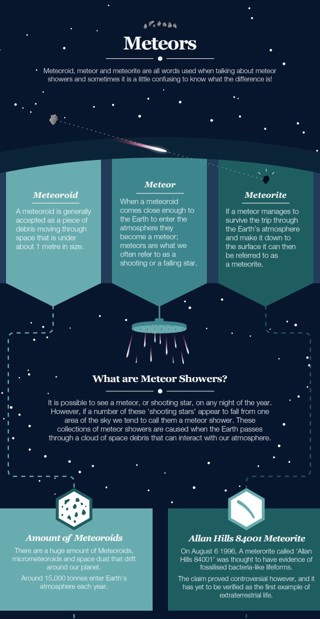
Lyrid Meteor Shower 2025
- 28th Mar 2025
- Author: Team Discovery (edited: Dhara Patel)
Lyrids
Cast your eyes to the sky in late April, and you might just catch a glimpse of the Lyrid meteor shower. Occurring in 2025 between 16 and 25 April, and peaking on the night of 22-23 April, the Lyrids are caused by Earth travelling through the dusty remnants of Comet Thatcher (C/1861 G1) and produce 10 to 20 meteors an hour in ideal conditions and circumstances.
Orbiting the Sun every 415 years, the long-period Comet Thatcher is responsible for the Lyrid meteor shower. Last seen from Earth in 1861, it won’t make an appearance in our night sky again until 2276.
However, each year Earth travels through the trail of dusty debris left by this comet on its last pass, and upon colliding with Earth’s atmosphere at high speeds, these pieces of debris burn up.
This creates streaks of light that whizz across the night sky - meteors. These bright trails are why meteors are often referred to as ‘shooting stars’ and are very exciting to watch!
How to Watch from the UK
To spot the shower for yourself, head outside to a dark site away from light pollution. This year, the shower peaks on the evening of 22-23 April. The waning crescent moon will remain below the horizon until around sunrise, so viewing conditions won’t be spoilt with moonlight.
The meteors will appear to originate from a point in the constellation Lyra. This point is known as the radiant. Find Lyra by looking for it’s brightest star Vega – one of the three stars of the Summer Triangle asterism.
However, since the meteors will travel away from the radiant, try to keep an eye on the whole sky. Wait for your eyes to adjust to the dark and with any luck, you’ll see between 10 to 20 meteors an hour!
For the best view of the Lyrids, head outside anytime between midnight and dawn when the radiant will climb higher into the south-eastern sky. While the peak is the optimum time to view the shower, if the weather doesn’t hold up, you can still try to spot them up until 25 April.
While the Lyrids aren't the most active of the annual meteor showers, they tend to be bright fast meteors, some with trains so can appear quite stunning if witnessed.
Meteor Infographic
Download our National Space Centre Meteor Shower Guide to make sure you are fully prepared!
Stay tuned in 2025 for upcoming meteor showers:
Eta Aquariids
Comet of Origin: 1P/Halley
Radiant: constellation Aquarius
Peak Activity: 5-6 May 2025
Peak Activity Meteor Count: up to 50 meteors per hour
Delta Aquariids
Comet of Origin: 96P/Machholz
Radiant: constellation Aquarius
Peak Activity: 30 July 2025
Peak Activity Meteor Count: up to 15 meteors per hour
Perseids
Comet of Origin: 109P/Swift-Tuttle
Radiant: constellation Perseus
Peak Activity: 12-13 August 2025
Peak Activity Meteor Count: up to 100 meteors per hour
Draconids
Comet of Origin: 21P/Giacobini-Zinner
Radiant: constellation Draco
Peak Activity: 8-9 October 2025
Peak Activity Meteor Count: up to 5 meteors per hour (In rare instances, fiery Draco has been known to spew forth many hundreds of meteors in a single hour.)
Orionids
Comet of Origin: 1P/Halley
Radiant: constellation Orion
Peak Activity: 21-22 October 2025
Peak Activity Meteor Count: up to 20 meteors per hour
Northern Taurids
Comet of Origin: 2P/Encke
Radiant: constellation Taurus
Peak Activity: 11-12 November 2025
Peak Activity Meteor Count: 5 meteors per hour
Leonids
Comet of Origin: 55P/Tempel-Tuttle
Radiant: constellation Leo
Peak Activity: 16-17 November 2025
Peak Activity Meteor Count: up to 10 meteors per hour
Geminids
Asteroid of Origin: 3200 Phaethon
Radiant: constellation Gemini
Peak Activity: 13-14 December 2025
Peak Activity Meteor Count: up to 150 meteors per hour
Ursids
Comet of Origin: 8P/Tuttle
Radiant: constellation Ursa Minor
Peak Activity: 21-22 December 2025
Peak Activity Meteor Count: up to 10 meteors per hour
Happy meteor-gazing!
Full references / credits:
(Banner image) Meteor showers. Credit: © National Space Centre
(1) Peak of the Lyrid meteor shower on 21 April 2012 taken by astronaut Don Pettit, then aboard the International Space Station. Credit: NASA/JSC/D. Pettit
(2) Lyrids radiant in the constellation of Lyra. Credit: Stellarium




